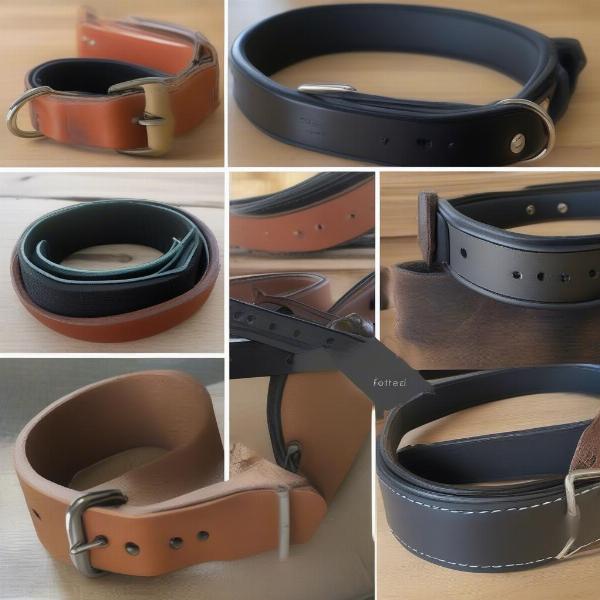Winter brings its own unique challenges for dog owners, and ensuring your furry friend stays warm and safe is paramount. While a warm dog coat is essential, don’t overlook the importance of a winter-appropriate dog collar. A well-chosen winter dog collar can provide extra comfort, visibility, and even a touch of festive cheer. Whether you’re looking for a durable, waterproof collar for snowy adventures or a reflective option for those dark winter walks, this guide will help you find the perfect winter dog collar for your canine companion.
Choosing the Right Winter Dog Collar
When selecting a winter dog collar, consider the material, functionality, and fit. Opt for materials that are both durable and comfortable against your dog’s skin, even when wet. Waterproof or water-resistant collars are a great choice for dogs who love splashing in puddles or playing in the snow. Reflective collars are crucial for enhanced visibility during those dimly lit winter evenings.
For dogs with thick winter coats, adjustable collars are a must to ensure a comfortable and secure fit. Consider the activities your dog enjoys during the winter months. If your dog is a fan of snowy hikes or romps in the woods, a durable and sturdy collar is essential.
Materials to Consider for Winter Dog Collars
Several materials excel in winter conditions. Biothane collars are a popular choice due to their waterproof, easy-to-clean nature. Neoprene, a synthetic rubber, offers excellent insulation and comfort, making it ideal for cold weather. Leather collars, while classic and stylish, require proper care to prevent damage from moisture.
 Dog Collar Materials for Winter
Dog Collar Materials for Winter
For added warmth, consider a collar with a fleece lining. This extra layer provides insulation and prevents chafing, especially for dogs with sensitive skin.
Ensuring Visibility in Dark Winter Months
Visibility is a crucial safety factor during winter. Reflective collars or collars with LED lights significantly increase your dog’s visibility in low-light conditions, making them easier to spot by drivers and other pedestrians.
Combine a reflective collar with a reflective leash for maximum visibility and safety during those dark winter walks.
Do I need a special winter collar for my dog?
While not strictly necessary, a winter-specific collar can enhance your dog’s comfort and safety during the colder months. Features like waterproof materials, reflective strips, and fleece lining can make a significant difference in your dog’s experience.
Can my dog wear their regular collar in winter?
Yes, your dog can wear their regular collar in winter, provided it fits properly and isn’t damaged. However, if your dog frequently gets wet or plays in the snow, a waterproof collar might be a more practical choice.
What are the best winter dog collar materials?
Biothane, neoprene, and waterproof nylon are excellent choices for winter dog collars. They are durable, easy to clean, and resistant to the elements.
Conclusion
Choosing the right winter dog collar involves considering factors like material, functionality, and fit. Prioritize comfort, durability, and visibility to ensure your dog stays safe and enjoys their winter adventures. A good winter dog collar can contribute significantly to your dog’s well-being during the colder months. Remember to adjust the collar as your dog’s coat thickens and always supervise your dog while they are wearing a collar.
FAQ
- How do I clean a winter dog collar? Most winter dog collars can be wiped clean with a damp cloth. For more stubborn dirt, use mild soap and water.
- What size collar should I get for my dog in winter? Measure your dog’s neck with a flexible tape measure and add a few inches for comfort. Account for any extra fur growth during winter.
- Are LED collars safe for dogs? Yes, LED collars are generally safe for dogs. Choose a collar with a durable, waterproof design and ensure the battery compartment is secure.
- Can I leave my dog’s collar on all the time in winter? While it’s generally safe to leave a collar on, it’s good practice to remove it periodically to check for any skin irritation or matting.
- How often should I replace my dog’s collar? Replace your dog’s collar as soon as you notice any signs of wear and tear, such as fraying or broken buckles.
Internal Links:
Look at these useful articles for more information on dog care: can dogs get fleas from grass, plaid dog bandana, and tartan dog coat.
About ILM Dog:
ILM Dog is your trusted international resource for comprehensive dog care advice. From breed selection and health to training and nutrition, we offer expert guidance for every stage of your dog’s life. Our expertise encompasses breed selection, health and medical care, training, nutrition, grooming, and finding the perfect products and accessories for your furry friend. We help you make informed decisions to ensure your dog thrives. Contact us for personalized advice: email [email protected] or phone +44 20-3965-8624.